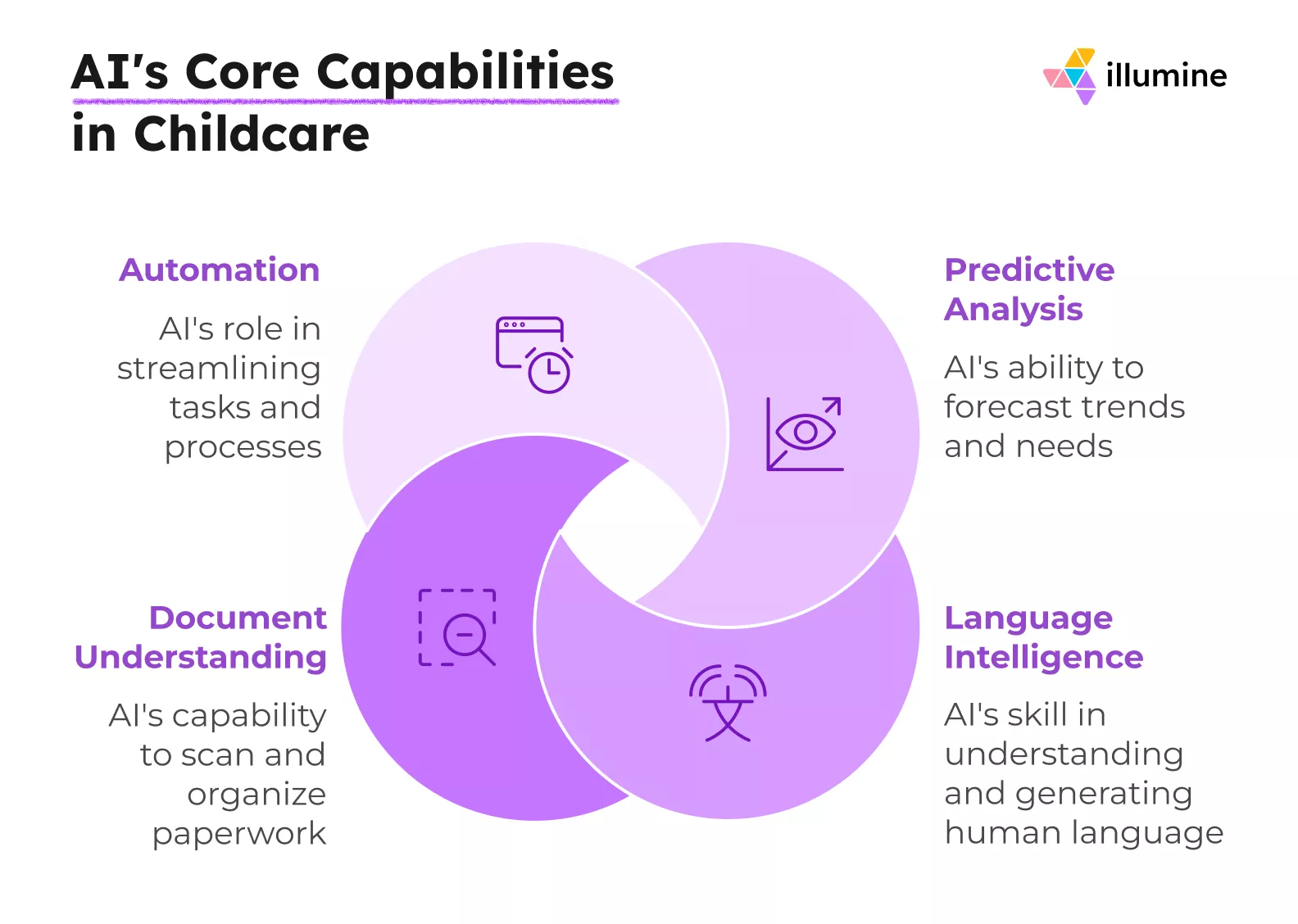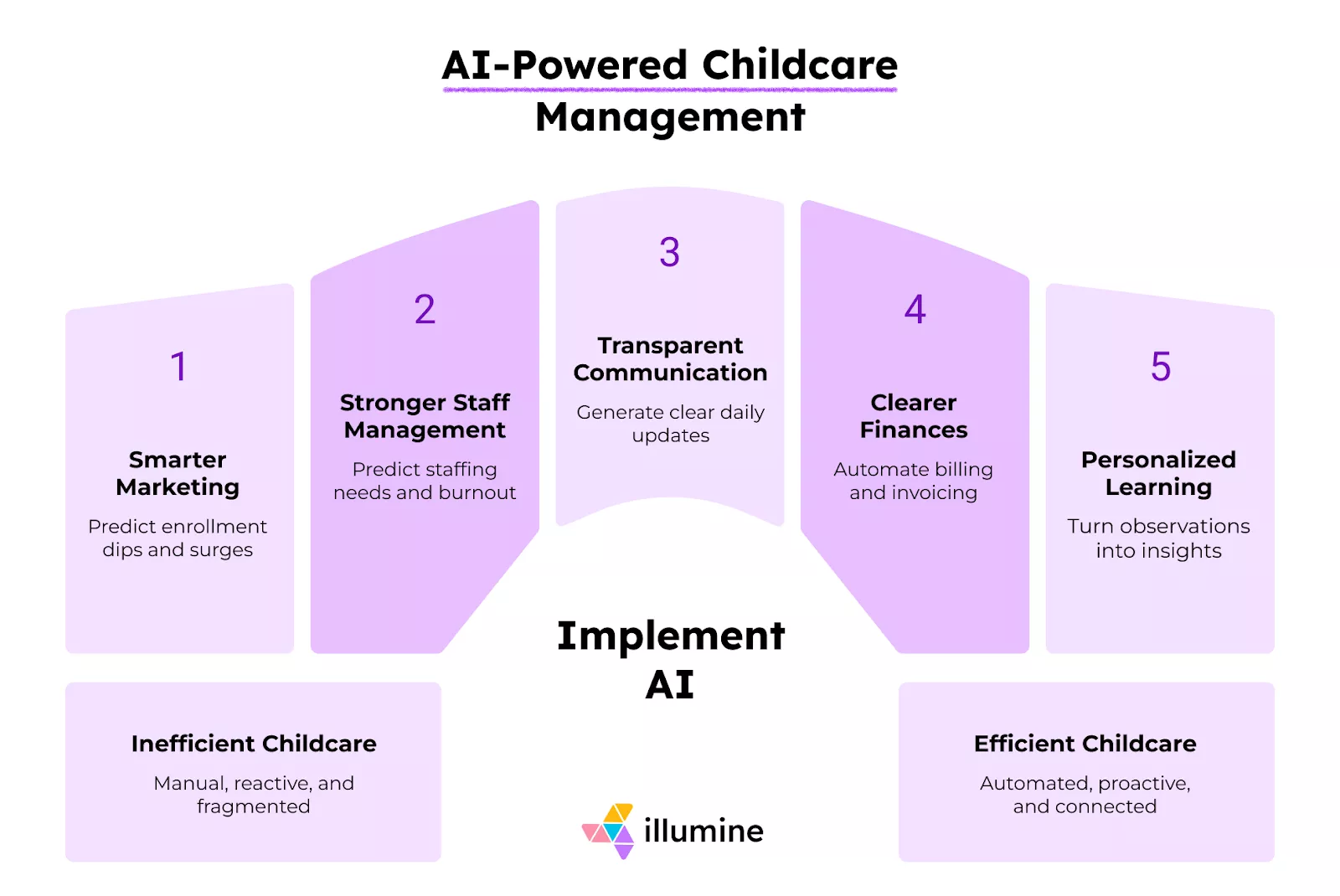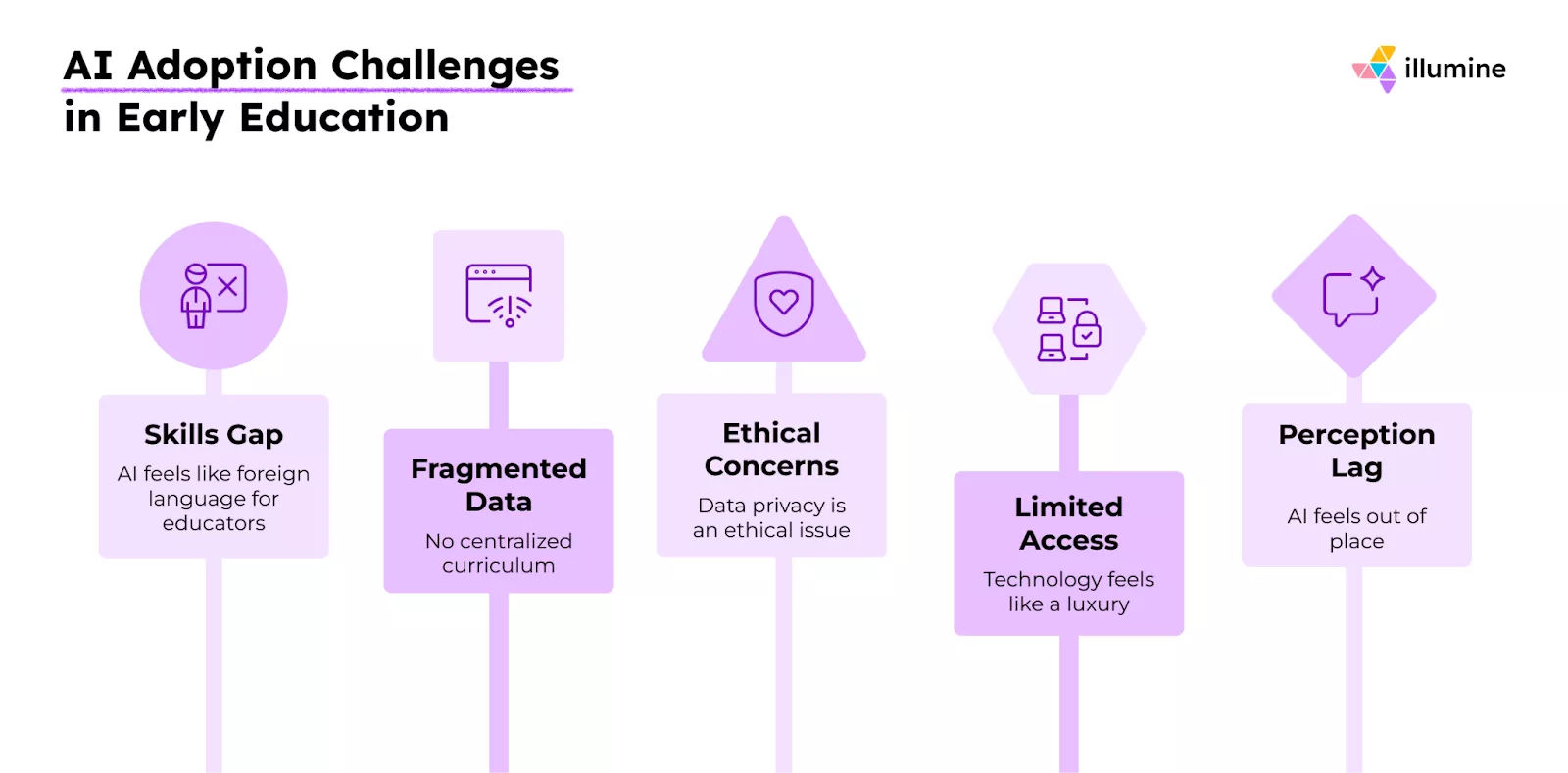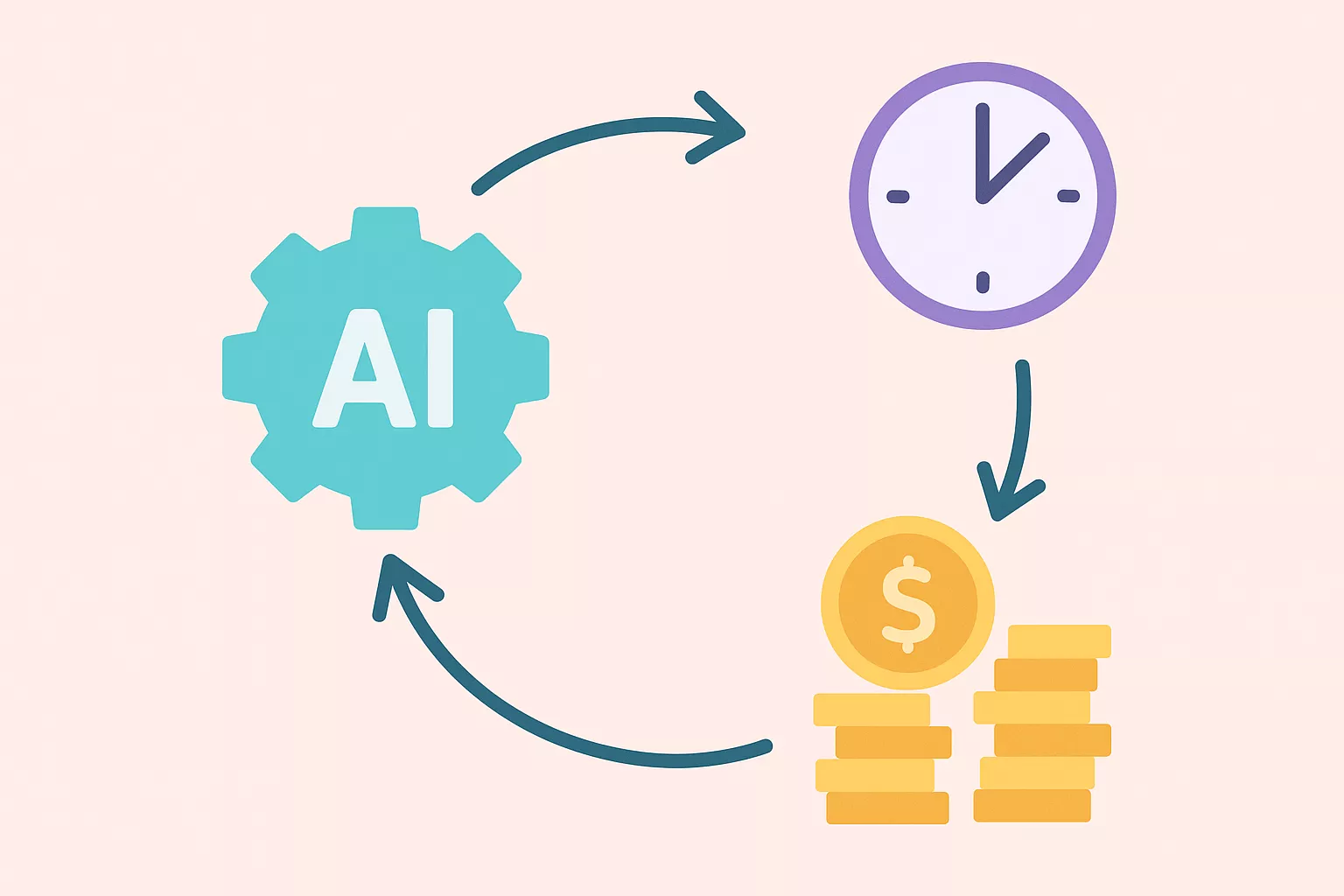AI sounds out of place in a preschool, doesn’t it?
Machines and algorithms in a room full of finger paint and giggles.
Childcare is, and will always be, an empathy-driven profession. That is why the mention of AI or automation often brings mixed reactions—confusion, curiosity, even a little apprehension.
And we believe things should be different.
It is no secret that early childhood educators are overworked, underpaid, and spend a chunk of their day on administrative tasks.
AI cannot replace a teacher’s instinct or foresight, but it can lift the administrative load that keeps teachers from using their time and talents where they matter most. It can quietly handle the repetitive, behind-the-scenes work that drains energy every day.
Here are the different ways in which AI can reshape early education—and why childcare owners should feel hopeful about it.
The Reality of Early Childhood Education Today
Before we jump in, let’s talk about the current state of childcare centers- Everyone in the system feels the strain. Families are juggling costs, educators are navigating burnout, and directors are fighting to stay afloat. The industry has reached a point where passion alone can’t keep it sustainable:
1. Parents
Childcare has never been more essential or more expensive.
Across the U.S., the cost of care has risen by 29% since 2020, outpacing both inflation and wage growth. Families now spend between 9% and 16% of their income on full-day childcare for one child. In many counties, the annual tuition bill is now higher than rent — and in some cases, even college tuition.
But this affordability crisis doesn’t mean centers are turning huge profits. In fact, most directors and teachers feel the pressure just as deeply as parents do.
2. Directors
Directors are trapped in a tough equation: rising costs on one side, limited flexibility on the other. Liability insurance premiums have increased by nearly 20% in the past year alone. Facility loans, rent, and utilities continue to climb. Health and safety requirements bring additional costs in staff training, inspections, and documentation.
And because compliance standards, safety ratios, and background checks are legally required, there’s no room to cut corners. A director can’t simply “do more with less” without risking quality or safety. For many centers, these fixed costs consume the bulk of their budget, leaving little for wages, enrichment, or innovation.
3. Teachers
Despite rising tuition, the people doing the actual work haven’t seen meaningful financial relief. The average early childhood educator earns $30,000 to $35,000 per year, barely above minimum wage in many states. Wages have remained largely stagnant for a decade, even as the cost of living and professional expectations climb.
Beyond the financial strain lies an invisible weight: administration. Teachers and directors spend nearly 30% of their workday managing paperwork — attendance records, subsidy forms, billing, documentation, and compliance reports. These chip away at what educators value most: time spent with children.
The result? A slow but steady exodus of talented teachers. Many have left for jobs in retail, hospitality, or other sectors that pay more for less emotional labor. Those who stay often shoulder double the workload to keep classrooms open, creating a cycle of burnout, turnover, and instability that ripples through entire communities.
There’s no real way to bring costs down without compromising on quality. The ratios, the regulations, and the rising prices are here to stay. What can change, however, is how efficiently centers operate.
By putting the right systems and technology in place, directors can reduce the administrative weight that eats into everyone’s day. Automating repetitive tasks, simplifying compliance, and giving teachers better tools doesn’t just make operations smoother. This creates more room for what truly matters: meaningful, one-on-one interactions with children.
When time and energy go back into teaching instead of tracking, the quality of care rises.
Parents see the difference, staff feel supported, and centers can finally justify their costs not through marketing, but through visible, consistent excellence.
The Benefits of Using AI in Early Childhood Education
When most people think of AI, they picture tools like ChatGPT or Gemini — clever assistants that answer questions or draft content.
But AI’s real power goes far beyond conversation.
Here’s what AI can actually do, and how those capabilities can reshape a director’s day-to-day work.
AI in early childhood education: core capabilities explained
1. Predictive analysis
AI’s strength lies in its ability to recognize patterns that people often overlook.
If you run a sunscreen brand, AI could study your sales data over the past year and instantly detect that demand spikes every June, dips in October, and rises again before spring break. You’d know exactly when to stock up — and when to hold back — long before those trends hit your bottom line.
Now imagine that same intelligence applied to your childcare center.
AI can analyze years of enrollment data to show you when inquiries peak, when drop-offs usually happen, and how long families typically take to convert after touring.
It can predict the financial impact of late payments, estimate your likely revenue for the next month, and even flag when food, classroom supplies, or payroll costs are trending above average.
Over time, these insights help you plan smarter — from deciding when to market aggressively, to how much to order for snacks and art materials, to whether you need to hire an extra substitute next quarter.
Predictive analysis gives you a clear, data-backed view of what’s ahead, so you can act early instead of reacting late.

2. Language intelligence
AI’s ability to understand and generate human language becomes incredibly valuable in childcare.
Think of it as a thoughtful assistant that listens, organizes, and writes with you.
AI can take a teacher’s voice note about a child’s morning — “Ava counted blocks up to 10 today and shared them with her friend”. AI can also turn it into a neatly written observation, ready to share with parents or add to the child’s learning record.
It can summarize long daily reports into quick updates, translate messages between parents and teachers in seconds, or help educators find the right words to describe progress without sounding repetitive or rushed.
For directors, language intelligence can also power internal communication.
It can draft newsletters, policy updates, or reminders in a clear, parent-friendly tone — ensuring consistency across teams while saving hours each week. Most importantly, it helps keep communication warm and human.
Instead of copying templates or wrestling with phrasing, teachers can focus on what they see and feel in the classroom while AI handles the writing.
3. Document understanding
AI can also scan, sort, and extract key details from all kinds of paperwork — whether it’s a parent’s registration form, a scanned invoice, or a stack of attendance sheets. It identifies what matters, organizes it neatly, and even spots errors or missing details before they become a problem.
For directors, this means no more hours spent matching receipts or reconciling attendance with billing.
For teachers, it means less time typing and more time teaching.
And for parents, it means fewer lost forms and quicker updates.
Document understanding replaces cluttered desks and endless folders with one organized, up-to-date digital record.
4. Automation
If predictive analysis is about foresight, and language intelligence is about communication, automation is about flow and the quiet system that keeps everything moving.
AI automation remembers tasks and does them for you.
It sends reminders for follow-ups, fills out recurring fields, and delivers reports on schedule — without you lifting a finger.
With AI, you can have a system with automatic billing, real-time attendance logs, automatic reminders to parents for due payments, and instant schedule updates for the staff.
No sticky notes. No missed steps. Just calm, steady operations.
For teachers, automation means daily reports and parent messages go out on time, even when the day runs long. For directors, it means compliance reports, renewals, and subsidy forms are handled on autopilot, leaving more room for strategy and staff support.
Practical Applications of AI in Early Childhood Education

So How do these AI capabilities Translate in Real-World Applications Today?
1. Smarter marketing and enrollments
For decades, childcare marketing has been a patchwork of hope and hustle. A few social media posts here, a banner outside the gate, a referral from a happy parent — and a silent wish that the next session fills up.
But that’s not a marketing system; that’s survival.
Directors spend too much time reacting to empty seats and not enough time planning how to keep them full. The problem isn’t the quality of your program — it’s that you’ve never had the right data to tell your story to the right families, at the right time.
This is where AI steps in. Not as another shiny tech tool, but as a way to make enrollment predictable, repeatable, and less dependent on luck.
Here’s how it helps:
- Predict enrollment dips and surges by studying inquiry, tour, and attendance trends — so you can act before empty seats appear.
- Forecast marketing ROI by linking campaign data with real enrollment outcomes, showing which efforts actually drive sign-ups.
- Automate lead nurturing, sending warm, personalized follow-ups to families who toured but haven’t enrolled. Platforms like illumine are already making this vision practical for childcare centers. Its admissions management system uses automation to track leads from inquiry to enrollment, send timely follow-ups, and keep every touchpoint (emails, calls, tours) in one place. That means fewer manual reminders, faster responses to families, and a clearer view of what’s working behind every enrollment.
- Optimize ad budgets by learning which platforms, posts, or keywords deliver the highest-quality leads.
- Refine your website and content through behavior insights — knowing which pages parents linger on or abandon helps you improve clarity and trust.
- Forecast revenue impact from enrollments and waitlists to plan staffing, budgeting, and expansion decisions with confidence.
AI gives childcare owners a full picture of their enrollment cycle. It not only helps understand how many families are interested, but why they convert, when they drop off, and what makes them stay.
It turns marketing from guesswork into strategy — and enrollment from a scramble into a steady rhythm.
2. Stronger staff management and scheduling
If you ask any childcare director what keeps them up at night, it’s not curriculum.
It’s staffing.
Ratios, sick days, last-minute callouts, overlapping breaks… It’s like solving a puzzle that changes shape every morning.
Most centers still run schedules on spreadsheets or message threads — which means when one piece moves, the whole day can fall apart. Teachers burn out, coverage gets stretched thin, and directors spend hours firefighting instead of leading.
AI doesn’t just simplify scheduling — it makes it smarter.
By studying attendance, historical patterns, and staff preferences, it can predict when coverage might tighten or when additional support will be needed.
Instead of reacting to chaos, directors can plan — and teachers can finally breathe.
Here’s how AI transforms staff management:
- Predict staffing needs based on enrollment patterns, seasonal demand, and absentee trends.
- Generate optimized schedules that balance coverage, breaks, and individual preferences while maintaining ratios.
- Forecast burnout risk by identifying patterns of overwork or excessive split shifts, helping leaders intervene early.
- Automate time tracking and attendance, ensuring accurate payroll without manual checks.
illumine’s digital attendance and staff scheduling tools automatically track check-ins, ratios, and real-time availability across classrooms. Directors can see who’s present, who’s on break, and which rooms need coverage in one unified dashboard. That visibility keeps centers compliant and helps prevent burnout by distributing workload more evenly.
- Streamline substitute management, matching available floaters or temp staff to classrooms that need coverage in real time.
- Analyze performance and training gaps, highlighting where additional support or development could improve retention.
AI protects human connection by removing the endless micromanagement and manual planning. It gives directors the one thing they’ve been missing most: time to lead their teams with intention, not exhaustion.
3. More transparent parent communication
Parents want reassurance more than they want updates.
They want to know their child is thriving, learning, and cared for, even when they can’t be there to see it. But for teachers, that kind of detailed communication takes time — time they usually don’t have.
Between managing classrooms, documenting observations, and responding to parent messages, teachers spend hours after dismissal writing reports instead of resting or planning for the next day. And when communication becomes inconsistent, parents start to fill in the silence with worry.
AI can bridge that gap by amplifying teachers’ voices. Here’s how it helps:
- Generate clear daily updates by summarizing activities, meals, naps, and learning milestones automatically.
- Translate messages instantly, ensuring that every parent — no matter their language — can understand their child’s progress and experiences.
- Personalize communication by learning each family’s preferences, whether they like quick snapshots or detailed reports.
- Turn teacher notes into polished observations, saving time without losing authenticity or warmth.
- Flag communication gaps (for example, if a family hasn’t received an update recently) so no parent feels left out.
- Create consistent newsletters and announcements in the center’s tone, freeing up staff from repetitive writing tasks.
The result is transparency that builds trust. Parents feel more connected, teachers feel less pressure, and directors gain a clear record of communication that supports compliance and quality assurance.
4. Clearer finances and administration
Every director knows this feeling: the spreadsheet tabs blur together, the invoices don’t line up, and there’s always one report due “by the end of the day.”
Managing the financial side of childcare is a balancing act between survival and sustainability, and it’s rarely the part anyone got into early education for.
Most centers don’t struggle because they’re careless with money, but because the system itself is fragmented. Billing lives in one tool, payroll in another, expense tracking in a third, so directors spend hours trying to make the math make sense.
AI can finally close that gap.
By pulling all your financial and operational data into one connected view, it helps you see patterns you couldn’t before — the kind that quietly make or break a center’s stability.
Here’s how AI helps directors and owners regain control:
- Automate billing and invoicing, with payment reminders sent automatically and late fees applied consistently.
Illumine is a childcare billing software that automates invoices, tracks payments in real time, and syncs data across locations, giving directors a clear, consolidated view of their finances. Multi-center owners can compare revenue and expense trends and make better budget decisions without juggling multiple systems.
- Forecast monthly revenue based on current enrollments, upcoming renewals, and seasonal trends.
- Identify cash flow risks early — from delayed parent payments to rising insurance or supply costs.
- Spot spending patterns by category (food, utilities, payroll, maintenance) and flag areas where waste or overuse is creeping in.
- Reconcile subsidy and payment data without endless manual entry or mismatched reports.
- Generate instant summaries for audits, board reviews, or licensing inspections with complete accuracy.
For multi-center owners, AI can go even further — comparing revenue and expense trends across locations, identifying what’s working best, and guiding smarter budget decisions.
With these insights, directors can stop reacting to financial fires and start making confident, forward-looking decisions.
5. Personalized learning and program quality
In the rush of forms, planning, and compliance, important moments with children often get reduced to quick notes and half-finished observations.
Teachers want to give every child individual attention, but personalization takes time — time they don’t have when they’re juggling documentation, communication, and lesson prep.
AI gives some of that time back by quietly working in the background. It can help teachers capture and understand each child’s journey more deeply without adding to their workload.
Here’s how AI can enhance program quality and learning outcomes:
- Turn observations into insights, helping teachers recognize patterns in a child’s behavior, interests, and growth over time.
- Suggest learning activities tailored to each child’s pace, strengths, and emerging skills — drawn from curriculum frameworks or past classroom data.
- Analyze classroom trends, such as attention spans, participation levels, or peer interactions, helping educators adjust approaches proactively.
- Simplify lesson planning, transforming basic inputs (“theme: transportation, age: 3–4”) into detailed, developmentally aligned plans with objectives and materials.
- Track developmental milestones automatically, so teachers can focus on interaction instead of paperwork.
- Create more holistic learning reports, blending academic progress with emotional and social growth — the parts that make each child unique.
AI essentially clears the noise so teachers can do what they do best — nurture curiosity, connection, and confidence in every child. This is exactly what platforms like illumine are helping teachers do. Its AI-powered preschool assessment tools turn quick classroom notes into rich, structured observations, helping educators connect the dots between behavior, learning, and progress. With automated milestone tracking and personalized lesson planning. Teachers can use it to create deeper, more meaningful learning experiences without spending their evenings buried in paperwork.
Challenges For AI In Early Childhood Education in Today’s Time
AI holds enormous promise for the childcare industry. But real transformation requires more than technology alone. The early education sector faces a unique mix of structural, ethical, and cultural barriers that make adoption slower than in other fields. Understanding these challenges is the first step to designing systems that work for teachers, children, and families alike.

1. Gap in teachers’ skills
For many early educators, AI still feels like a foreign language.
Not because they’re resistant to change — but because nobody ever taught them how to use it in a way that makes sense for their world.
Most teachers didn’t step into this field to learn new software. They chose early education because they love children, not dashboards.
But between lesson planning, family communication, and compliance reports, the idea of learning yet another “system” can feel like one more weight on already tired shoulders.
The truth is, the hesitation isn’t about technology. It’s about time, trust, and relevance.
Educators need to see how AI can help them, not just hear about it.
That’s why training shouldn’t be a one-time webinar or a manual nobody reads. It should be hands-on, ongoing, and classroom-centered — showing teachers exactly how AI can make their daily routines lighter.
When educators experience how AI helps them write observations faster, track milestones effortlessly, or translate messages for parents in seconds, skepticism turns into relief.
And relief is where adoption begins.
2. Fragmented curriculum and data gaps
AI is only as smart as the information it learns from.
In childcare, that’s where one of the biggest challenges begins. Unlike K–12 education, early learning doesn’t follow one unified system.
Every center has its own approach: Montessori, Reggio, EYFS, or a blend of philosophies built through years of experience. It’s what makes early education beautiful — but also what makes it hard for AI to step in. Without a consistent structure, there’s no shared “language” for the technology to learn from.
In practice, that means one teacher might track a child’s milestones in detailed narratives, while another uses checkboxes. One center might document progress weekly, another monthly. The result? Valuable insights are scattered across forms, spreadsheets, and notebooks.
That’s not a failure of teachers. It’s a system that was never designed to be data-friendly.
AI can help bring order to that chaos. By mapping a center’s existing methods against standardized frameworks like EYFS or Montessori, it can fill in gaps and spot developmental trends that might otherwise go unnoticed.
Imagine a tool that gently organizes the information teachers already collect and turns it into patterns directors can actually use to refine programs or demonstrate impact.
The goal isn’t to replace philosophies with formulas, but to make every child’s growth story clearer, and every teacher’s effort leaves a measurable mark.
3. Ethical and privacy considerations
Parents trust teachers with their children’s safety, learning, and emotional well-being every single day. So it’s natural that the idea of AI and automation raises a few eyebrows.
When we talk about “data” in childcare, we’re not just talking about numbers.
We’re talking about children’s faces in photos, progress notes, attendance logs, and even the small details teachers jot down during the day — what a child ate, how long they napped, when they smiled. Those are deeply personal moments.
That’s why data privacy isn’t just a technical issue; it’s an ethical one. Directors and owners need to know exactly what happens to their data — who sees it, where it’s stored, and how it’s used. Parents should be able to give clear, informed consent and have confidence that their child’s information is safe.
And AI systems need to be transparent enough that educators understand how decisions or suggestions are made. AI can not be a “black box” that they trust blindly.
The opportunity here isn’t just about compliance; it’s about communication.
When families and teachers understand that privacy is protected, AI stops feeling like a risk and starts feeling like a partner.
That’s how innovation and integrity can finally coexist in childcare — side by side, just like teachers and the children they care for.
4. Limited access to technology
Before AI can transform childcare, it has to reach it. And that’s still one of the biggest barriers today.
Many small, community-based centers are doing incredible work with very limited resources. They rely on handwritten attendance sheets, basic Excel trackers, and parent communication through WhatsApp or paper notes. When budgets are tight, technology often feels like a luxury rather than a necessity.
But the irony is that the same tools that could ease this workload often stay out of reach for the people who need them most.
Between subscription costs, outdated devices, and patchy internet connections, digital tools can feel like another mountain to climb instead of a helping hand.
That’s why accessibility isn’t just a technical issue — it’s a matter of equity.
AI tools designed for early education need to meet teachers where they are. They should work on any device, even offline when needed, and integrate smoothly with existing workflows so they don’t demand a total system overhaul.
Imagine if every center, no matter its size or location, could use AI to simplify reports, track growth, or communicate with parents — without needing new hardware or a full-time IT team.
That’s when AI stops being a privilege and starts becoming progress.
The goal is to democratize childcare more than to digitize it.
5. Perception and policy lag
Even with all its promise, AI still has an image problem. For many educators, the idea feels out of place in a space built on warmth, intuition, and human connection.
That hesitation makes sense. Childcare runs on relationships, not algorithms. Teachers notice when a child is quieter than usual, or when a smile doesn’t quite reach their eyes — no machine can replicate that kind of understanding. But technology can take over the paperwork, scheduling, and endless compliance tracking. Teachers get their time and energy back so they can focus again on what truly matters: children.
But the challenge isn’t just perception; it’s also policy.
Most early education frameworks still don’t include clear guidelines for using AI in classrooms. Without direction, directors are left guessing what’s compliant and what’s risky — and that uncertainty slows innovation.
The opportunity ahead is to reshape both mindset and regulation. Policymakers, tech developers, and educators need to work together to set standards that keep children safe and help teachers thrive. When that happens, AI won’t feel foreign to childcare — it will feel like the quiet, reliable support system it was always meant to be.
Building a Future with AI in Early Childhood Education
The conversation around AI in childcare shouldn’t be about replacing people — it should be about releasing them from work pressure and burnout.
Here’s what childcare leaders, teachers, and policymakers can start doing today to help AI truly take root responsibly and meaningfully:
1. Start with small, practical wins
You don’t need to overhaul your entire center overnight. Begin with tools that solve one visible pain point — automating daily reports, organizing staff schedules, or simplifying billing. Once your team experiences relief in one area, their confidence in technology grows naturally.
2. Invest in hands-on training
Technology doesn’t stick when it’s taught in theory. Set up small workshops where teachers can practice using AI tools in real scenarios — writing observations, preparing lesson plans, or translating parent messages. When they see time coming back to them, adoption follows effortlessly.
3. Choose tools that meet you where you are
The right AI platform should fit into your existing rhythm, not force you to rebuild it. Look for solutions that are affordable, intuitive, and flexible enough to adapt to your workflow — whether your center runs on tablets, laptops, or paper binders.
4. Lead conversations about ethics and transparency
Don’t wait for policy to catch up — start setting your own standards. Tell parents how data is used, where it’s stored, and why it matters. Make transparency a part of your culture. When families understand that AI protects rather than risks their privacy, trust deepens across the board.
5. Build a shared language around data
Help your teachers understand that “data” doesn’t mean numbers — it means stories about children’s growth. Use AI to connect the dots between daily observations, developmental goals, and long-term outcomes. When educators see data as a reflection of care, not compliance, they use it more thoughtfully.
As leaders and educators, your experiences shape the policies that follow. Join conversations about responsible AI use in early childhood education. Push for guidelines that support teachers’ well-being, equity, and access, not just efficiency.
Closing Thoughts
AI is a tool for sustainability in a field that desperately needs it.
The question isn’t whether childcare will use AI, but how we’ll use it: thoughtfully, collaboratively, and always in service of the people who make early education what it is.
When teachers feel supported, parents feel connected, and directors feel in control, that is when technology truly earns its place.










.webp)